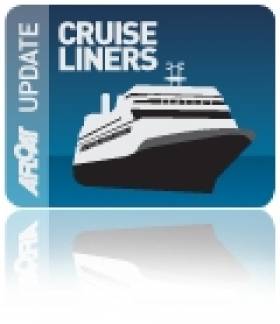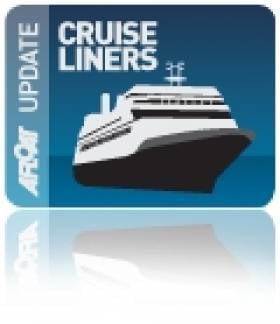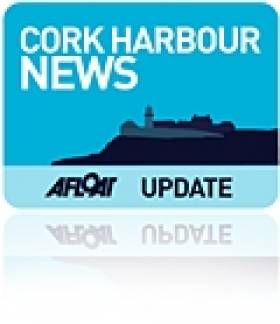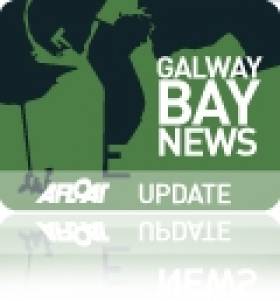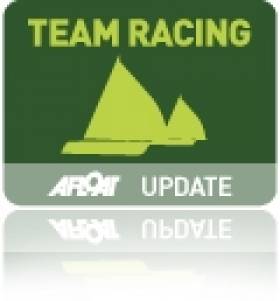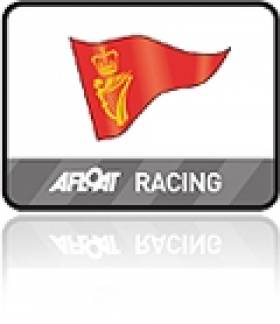Displaying items by tag: Cork
MV Queen Elizabeth Makes Maiden Call to the Port of Cork
The luxurious ocean liner, MV Queen Elizabeth will make her maiden call to Cobh tomorrow morning arriving at 9am and bringing with her over 3,000 passengers and crew. With a gross tonnage of 90,900 GRT and a guest capacity of 2,068 and 996 crew, MV Queen Elizabeth is the newest Cunarder to join the fleet.
To coincide with her maiden call, the Port of Cork together with Cunard will hold a Lusitania Memorial Service in the centre of Cobh town. Led by Captain Christopher Wells, this service will be attended by the Chairman of the Port of Cork, Port of Cork Directors, Mayor of the Town of Cobh, the County Mayor and the Lord Mayor. A number of other key figures have also been invited.
Cunard have a great history of calling to the Port of Cork and over the years all of Cunard’s liners have made a visit to Cobh. This year is the first year to welcome all three queens; Queen Mary II, Queen Victoria and Queen Elizabeth to Cobh. In 2009, MV Queen Elizabeth II made her final call to Cobh before departing for Dubai where she was to become a floating hotel.
The following will be read at the Lusitania Memorial Service, by Captain Michael McCarthy Port of Cork;
The sinking of the Lusitania on 7th May 1915 was a human catastrophe on a scale that this small town had not experienced before or since.
When the Lusitania left New York there were 1,962 people on board, 694 crew,1,265 passengers and 3 stowaways. Only 764 people survived – 474 passengers and 290 crew. Over 800 of the victim’s bodies were never found. The bodies landed in Cobh were buried in 3 mass graves in the “Old Church Cemetary”.
The People in Queenstown, Cobh, witnessed the trauma, tragedy and heartbreak that ensued. The dead, the injured and the bereaved were brought among a community here that mobilised itself and responded with courage and compassion to their needs. One of the survivors, Charles Lauriat, later referred in his book “The Lusitania’s Last Voyage” to the streets filled with people ready to do anything in their power to relieve our sufferings. He said he had never seen anything more spontaneous or genuine or more freely given than the Irish hospitality of Queenstown.
This memorial reflects the eternal connection between Cobh, the” Lusitania” and Cunard, and is a stark reminder of the tragedy of war.
It is fitting that today Captain Christopher Wells of Cunard’s vessel “Queen Elizabeth” should be here together with the Mayor and people of Cobh to reflect on the great loss and the human tragedy of the “Lusitania”.
Queen Elizabeth: 73 years ago, Cunard’s first “Queen Elizabeth” entered service. The launching of that ship was described as “the inception of a great human enterprise, an act of faith”. Could they have imagined the design and capability of the current vessel berthed at the Cobh Cruise Berth?
In October 2008, Cunard announced the building of this magnificent vessel at an estimated cost of €500 million euros, and within 2 years the naming ceremony was carried out in Southampton by Her Majesty Queen Elizabeth 11,. The vessel departed on her Maiden voyage under the command of Captain Chris Wells on the 12th October 2010 .She has already completed a World voyage, transited the Suez and Panama Canals and crossed the World’s Oceans.
Captain Wells has already served a long and distinguished career in the Merchant Navy and following many years in command, was in 2008 appointed Master of the Queen Mary 2, the same year the QE2 was retired from the Cunard Fleet. He was subsequently appointed the first Master of the Queen Elizabeth in 2009
Free Ferry for Cork Harbour Open Day
Queen Elizabeth Arrives on Dublin Bay
Port of Cork to Mark Maiden Arrival of MV Queen Elizabeth
On Saturday 10th September 2011, MV Queen Elizabeth will make her maiden call to Cobh in the Port of Cork. To coincide with this visit the Port of Cork will formally present a plaque to the Captain of the Queen Elizabeth on the quayside at 10.30am.
This will be followed by a Lusitania Memorial Service led by the Captain and Chairman of the Port of Cork at the memorial in Cobh Town.
Saturday 10th September 2011
0900hrs - MV Queen Elizabeth arrives in Cobh
1045hrs – Plaque exchange with Port of Cork and Cunard
1115hrs – Lusitania Memorial Service Begins in the centre of Cobh Town
1145hrs – Memorial Service Ends
1145hrs – 1245hrs – Band 1 Southern Brigade will play in the promenade in Cobh
Third Cork Harbour Open Day Set for this Weekend
This year Cork Harbour Open Day is set to be a great day with so much happening all around the harbour. Now in its third year, Cork Harbour Open Day has grown and each year offers more and more activities both on and off the water.
The day itself is a great day for people to see exactly what Cork Harbour has to offer, and this year is no exception with the second largest natural harbour in the world will playing host to the Cobh to Blackrock sailing race, kayaking on the River Lee, crab fishing in Cobh, and for the first time a free open day at the National Maritime College of Ireland (NMCI) in Ringaskiddy and Fastnet Lines MV Julia open to the public for tours and lunch.
Cork Harbour Community Radio will broadcast throughout the day on frequency 98.3FM live from the NMCI. This community radio initiative is part of a response to the great sense of community developing in the Cork Harbour area and has been made possible by the combined effort and support of many harbour side groups and organisations.
This year will also see the first ferry shuttle service operated by 'Whale of a Time' and sponsored by the Port of Cork and NMCI running in the lower harbour calling at Ringaskiddy, Monkstown, Cobh, Aghada and Crosshaven. Free to anyone who wishes to use it, this ferry will be a great way to see the harbour and get around to the different locations and attractions.
Visitors to Ringaksiddy will be given the opportunity to go on a free guided tour around the National Maritime College of Ireland and see their panoramic bridge ship simulators, the survival pool and the marine workshops. Staying in Ringaksiddy, at the Deepwater Quay, Fastnet Lines' MV Julia will open to the public giving people the chance to go onboard the ferry and even have some lunch if they wish. In the evening, Cork Corona Film Festival will hold a fundraiser themed the 'Amazing Cork Maritime Experience' at the NMCI from 5pm onwards.
In Cobh, Cunard's MV Queen Elizabeth will make her maiden call to the Port of Cork and to coincide with this visit, Cunard and the Port of Cork have organised a Lusitania Memorial Service in Cobh led by the Captain of Queen Elizabeth. To add to the occasion, Band 1 Southern Brigade will play in the promenade after the service. Both events are free and open to all.
In the afternoon 'See You in Cobh' will run a crab fishing competition for kids. The Irish Coastguard, RNLI and the Search and Rescue Helicopter will perform a search and rescue demonstration in the lower harbour near Monsktown and Ringaskiddy at 3pm. At 5pm when MV Queen Elizabeth departs a 'Fond Farewell' is being organised to encourage spectators around the harbour to wave this great ocean liner off as she departs Cork harbour. Great locations around the harbour to see the departure are Roches Point, Weavers Point, Camden Fort, Cobh town or Whitegate.
Spike Island will be open to the public all day, with boat rides operating from Kennedy Pier in Cobh to the island throughout the day. Live music, face painters, clowns and jugglers will be on the island to entertain and visitors to the island are being encouraged to bring their own picnic for the day.
In Crosshaven, the Rescue Camden Committee have organised a free open day from 12-6pm. The fort will host the Airborne 101 re-enactors and a weapons display and a 'Port in Pictures' photograph exhibition. Camden Fort is a perfect location to watch MV Queen Elizabeth as she departs Cobh at 5pm. Crosshaven will also hold their annual triathlon at 4pm.
In Cork City, the Irish naval vessel L.E.Ciara will be open to the public for free tours of the ship from 11am to 4pm. Also in the morning visitors will get to see the amazing 150 cars taking part in this year's Cannonball Run in aid of Barretstown Kids charity, as they depart Custom House quay at 11am. Blackrock Castle Observatory will present their theatrical tours bringing the colourful story of the castle to life from 400 years ago to present day. A great venue for all the family and a super location to watch the Cobh to Blackrock sailing race, as the yachts head up the river.
In Aghada, there will be tales and stories of the south east side of the harbour throughout the day held in Rosies Bar. Visitors can use the ferry shuttle which would take them to Aghada's new pontoon facility recently opened.
Aimed at embracing what Cork Harbour has to offer, the Cork Harbour Open Day aims to raise awareness of the different activities available for people in the harbour both on and off the water. It's a great day for all the family with many events free to everyone.
The idea for a Harbour Open Day emerged from discussions between various stakeholders involved in the development and implementation of the Integrated Strategy for the Harbour. A group comprising representatives from UCC, City and County Councils and the Port of Cork set about working together to engage users of the Harbour and to organise the Open Day.
Triathletes Cross the Line at First Galway Ironman
RTÉ presenters Kathryn Thomas and Gráinne Seoige were among the 2,000 competitors who crossed the finish line at the Ironman triathlon in Galway yesterday.
According to the Irish Independent, the duo took part in the relay competition in aid of Irish Autism Action.
Meanwhile, fellow celebrity and Boyzone star Keith Duffy took on the challenge of completing the entire 70.3-mile course, finishing with a time of 5 hours 40 minutes.
The first Ironman event to be held in Galway comprised a swim across Galway Bay, a 90km cycle across Connemara and a 21km run through the streets of the City of the Tribes.
However adverse conditions at the start of the race saw the swimming stage reduced from 1.9km to 1km for safety reasons.
Among the elite competitors, first home was Switzerland's Mike Aigroz, with a time of 3:50:12. Best among the Irish men was Cork's Owen Cummins at 4:01:26.
Britain's Lucy Gossage came first in the women's section at 4:02:09, while Irish national record holder Joyce Wolfe set a time of 5 hours 44 seconds.
Correction: The original version of this story had the distance of the swimming stage as reduced from 1.9km to 700m, but the official Ironman Galway website confirms the swim distance as 1km.
An exotic weekend in Dun Laoghaire with the start of an Olympic class keelboat event plus the arrival of a Volvo 70 into the harbour but Irish weather meant all did not go to plan. Click our links for a round up of the weekend's sailing events from around the country: Mansfield Wins 1720 Euros in Baltimore, Squall Puts Paid to First Race of Star Europeans in Dun Laoghaire, West Kirby Teams Top ISAF Worlds in Schull, Johnston's Beneteau 31.7 is Good Prospect, Killyleagh Pair Scoop Flying Fifteen East Coast Cup, Lively Lady Sails to Victory in Fickle ISORA Race to Rockabill, SB3 Team Sanya Welcome Scuppered by Strong Winds. We'll have more reports later this morning from the J24 Easterns in Howth, the National 18 season in Cork and J80 Match racing.
West Kirby Teams Top ISAF Worlds in Schull
Saturday's racing in the ISAF World Team Racing Championships in Schull Harbour began in light southwesterly winds which developed into a fresh northwesterly by late morning. First action was the semi-final stages of the World Youth Championship.
Here, the host club Schull Community College, representing Ireland, took on Sevenoaks (GBRY2) while the in form Spanish team from Barcelona took on the top ranked British team West Kirby Youth (GBRY1),each in a five race sail off for a place in the World Final. Schull opened with two winning combinations but Sevenoaks hit back ,winning the third with a 1,3,4 combination. However, Schull C.C. took the fourth race to clinch a place in the final.

In the second semi the Spanish opened with a flourish and had two wins under their belt before West Kirby Youth seemed to realise they were in a World semi-final and looking defeat in the face. Their backlash came hard and fast. They took the next two
races to level the match and in a dramatic fifth race decider, in which the Spanish team fought to the finish, they secured their final place.
There was huge local anticipation and excitement entering the final with the host club facing the possibility of a World Youth title. However ,they had a shaky start losing the first of the five races.This brought about a loss of composure and with a few penalty umpiring calls going against them, and deservedly so, they forfeited the second race also to a humbling 1,2,3, combination from the British team. A lesser team might have caved in at this stage, but they rallied and hit back, winning the third and fourth races.The final deciding race was contested with passion ,commitment and no little skill, with the home team looking like they would just steal the march with a winning combination approaching the finish, but a finish line infringement cost them the race and the title. West Kirby Youth( GBR3) are the World Youth Team Racing Champions 2011, a tribute to their skill, consistency and discipline throughout this World Championships.
The third place sail off between the Spanish team and Sevenoaks (GBRY2) resulted in a win for the Spanish who, together with the first and second placed youth teams,joined the five Open qualifiers who made the cut, in the Open quarter finals.
This was sailed as a round robin, with the four top ranked teams from the USA and Great Britain making it to the semi- finals, namely, NCYC Team Extreme (USA1), Woonsocket Rockets (USA2), West Kirby Hawks( GBR1) and Wessex Exempt (GBR2). The placings meant that both USA and British semi – finalists were pitted against each other in the penultimate round ensuring a Britain v USA final.
At this stage form and consistency came to the fore with Team Extreme and West Kirby Hawks securing their final berths with three straight wins over their fellow countrymen .
West Kirby Hawks attacked early on and took the first race of the final with a convincing 1,2,3 win. Team Extreme hit back taking the second 1,2,5. The third race proved crucial with Hawks' master tactician Andy Cornah, king of the Championship, working himself and Dom Johnson into 1,2 positions to snatch the win. This proved the race that smashed the American challenge as Team Extreme's Zach Brown was over at the start in the fourth and The Hawks stole in at 1,2,3 , a lead they didn't relinquish. At three races to one the Championship was over and West Kirby Hawks, Great Britain's top ranked team racers ,are worthy ISAF World Team Racing
Champions 2011 and have avenged their defeat by USA's Team Extreme in the British Open Team Racing Wilson Trophy Final back in May of this year. The bronze medallists are Woonsocket Rockets (USA2) who defeated Wessex Exempt(GBR2) with three straight wins in the sail off for third place.
RESULTS
OPEN WORLD CHAMPIONSHIP :
1. West Kirby Hawks ( GBR1)
Helms: Andy Cornah, Ben Field, Dom Johnson.
Crews: Hamish Walker , Tom Foster, Deborah Steele.
2. NYYC Team Extreme (USA1)
Helms: Zach Brown, Peter Levesque, Stuart Mcnay
Crews: Emmet Smith, Marla Menninger, Michael Hession.
3. Woonsocket Rockets (USA2)
Helms: Joel Hanneman, Brian Kamilar, Justin Law.
Crews: Alexa Schuler, Lyndsey Gibbons- Neff, Adrienne Patterson.
YOUTH WORLD CHAMPIONSHIP:
1. West Kirby Youth ( GBRY1)
Helms: Cameron Douglas, Ben Robinson,Sophie Shepherd.
Crews: Sarah Lombard, Charlie Fitzgerald, FreddyWilliams.
2. Schull Community College (IRLY3)
Helms: Conner Miller, Oisin O' Driscoll, Jay Stacey
Crews: Ellen O' Regan, Katie Moynihan, Kasper Snashall.
3. Spain (ESPY1)
Helms; Carlos Robles, Adriana Rodes, Jordi Xammer.
Crews: Florian Trittel, Lucia Brugman, Alex Claville.


























